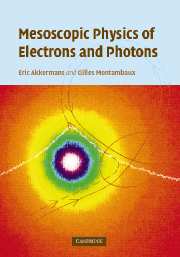Book contents
- Frontmatter
- Contents
- Preface
- How to use this book
- 1 Introduction: mesoscopic physics
- 2 Wave equations in random media
- 3 Perturbation theory
- 4 Probability of quantum diffusion
- 5 Properties of the diffusion equation
- 6 Dephasing
- 7 Electronic transport
- 8 Coherent backscattering of light
- 9 Diffusing wave spectroscopy
- 10 Spectral properties of disordered metals
- 11 Universal conductance fluctuations
- 12 Correlations of speckle patterns
- 13 Interactions and diffusion
- 14 Orbital magnetism and persistent currents
- 15 Formulary
- References
- Index
10 - Spectral properties of disordered metals
Published online by Cambridge University Press: 06 January 2010
- Frontmatter
- Contents
- Preface
- How to use this book
- 1 Introduction: mesoscopic physics
- 2 Wave equations in random media
- 3 Perturbation theory
- 4 Probability of quantum diffusion
- 5 Properties of the diffusion equation
- 6 Dephasing
- 7 Electronic transport
- 8 Coherent backscattering of light
- 9 Diffusing wave spectroscopy
- 10 Spectral properties of disordered metals
- 11 Universal conductance fluctuations
- 12 Correlations of speckle patterns
- 13 Interactions and diffusion
- 14 Orbital magnetism and persistent currents
- 15 Formulary
- References
- Index
Summary
In this chapter we denote by v0, the average density of states per spin direction and by ρ0 = v0/Ω, the density of states per unit volume. The characteristic energy Δ = 1/(ρ0Ω) = 1/v0is the average spacing between energy levels per spin direction. We set ħ = 1.
Introduction
In the previous chapters, we have considered different signatures of the phase coherence on average values of transport quantities such as the electrical conductivity or the albedo. In order to observe such coherent effects, it is necessary to couple the disordered medium to the outside world, such as electric wires for the conductivity or the free propagation medium for the albedo. However, it is also possible to characterize isolated disordered systems by measuring their spectral properties.
A disordered medium can be viewed as a complex system whose energy or frequency spectrum cannot be described by means of a given deterministic series of numbers. The nature of the spectrum and of its correlations reflects different physical properties. For example, the spectrum of a disordered metal is quite different if it is a good or a bad conductor. The understanding of these properties is essential for the description of thermodynamic properties such as orbital magnetism or persistent current, which we shall study later and which express the sensitivity of the spectrum to an applied magnetic field or to an Aharonov–Bohm flux (Chapter 14).
The purpose of this chapter is to describe the spectral properties of a disordered metal by means of statistical methods.
- Type
- Chapter
- Information
- Mesoscopic Physics of Electrons and Photons , pp. 370 - 395Publisher: Cambridge University PressPrint publication year: 2007

